| Motto | Medical research. Practical action |
|---|---|
| Established | 1986 |
| Mission | Medical research, education and public health |
| Chair | Mary Padbury |
| Director and CEO | Brendan Crabb AC |
| Faculty | |
| Staff | approx. 450 |
| Key people |
|
| Budget | A$39 million (2015) |
| Formerly called |
|
| Location | Commercial Road, Prahran , , , Australia |
| Website | www |
| [1] [2] | |
The Burnet Institute is an Australian medical institute that combines medical research in the laboratory and the field, with public health action to address major health issues affecting disadvantaged communities in Australia, and internationally. [3]
As of 2011, the institute was home to more than 450 medical researchers, working across six main themes: infectious diseases; maternal and child health; sexual and reproductive health; alcohol and other drugs harm reduction; immunity, vaccines and immunisation; and the health of young people.
With a head office located in Commercial Road, Prahran, Victoria, the institute delivers public health programs across four continents including Africa, Oceania, and Asia and is led by its director and chief executive officer, Professor Brendan Crabb AC , an immunologist.
Burnet Institute has particular expertise in infectious diseases (especially HIV, hepatitis viruses, influenza and malaria) and in understanding the immune responses to these infections. Their work also focuses on sexual health, drug and alcohol use, both in risky behaviours associated with infectious diseases and as major health problems in their own right. Translating new knowledge into tangible and practical health outcomes is also a major focus of the institute. [4]
The Institute grew out of the Virus Laboratory at Queen's Memorial Infectious Disease Hospital, Fairfield Hospital and was founded in 1986, named in honour of Sir Frank Macfarlane Burnet as the Macfarlane Burnet Centre for Medical Research, Burnet was a Laureate of the 1960 Nobel Prize for Medicine. The institute's official name is the Macfarlane Burnet Institute for Medical Research and Public Health, more commonly known as the Burnet Institute. [2] In 2002, the Austin Research Institute merged with the Burnet Institute.

The National Institutes of Health, commonly referred to as NIH, is the primary agency of the United States government responsible for biomedical and public health research. It was founded in the late 1880s and is now part of the United States Department of Health and Human Services. Many NIH facilities are located in Bethesda, Maryland, and other nearby suburbs of the Washington metropolitan area, with other primary facilities in the Research Triangle Park in North Carolina and smaller satellite facilities located around the United States. The NIH conducts its own scientific research through the NIH Intramural Research Program (IRP) and provides major biomedical research funding to non-NIH research facilities through its Extramural Research Program.

Barry James Marshall is an Australian physician, Nobel Laureate in Physiology or Medicine, Professor of Clinical Microbiology and Co-Director of the Marshall Centre at the University of Western Australia. Marshall and Robin Warren showed that the bacterium Helicobacter pylori plays a major role in causing many peptic ulcers, challenging decades of medical doctrine holding that ulcers were caused primarily by stress, spicy foods, and too much acid. This discovery has allowed for a breakthrough in understanding a causative link between Helicobacter pylori infection and stomach cancer.

Sir Frank Macfarlane Burnet, usually known as Macfarlane or Mac Burnet, was an Australian virologist known for his contributions to immunology. He won a Nobel Prize in 1960 for predicting acquired immune tolerance and he developed the theory of clonal selection.
The National Institute of Allergy and Infectious Diseases is one of the 27 institutes and centers that make up the National Institutes of Health (NIH), an agency of the United States Department of Health and Human Services (HHS). NIAID's mission is to conduct basic and applied research to better understand, treat, and prevent infectious, immunologic, and allergic diseases.
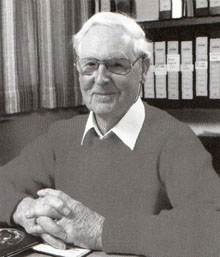
Frank John Fenner was an Australian scientist with a distinguished career in the field of virology. His two greatest achievements are cited as overseeing the eradication of smallpox, and the attempted control of Australia's rabbit plague through the introduction of Myxoma virus.

WEHI, previously known as the Walter and Eliza Hall Institute of Medical Research, and as the Walter and Eliza Hall Institute, is Australia's oldest medical research institute. Sir Frank Macfarlane Burnet, who won the Nobel Prize in 1960 for his work in immunology, was director from 1944 to 1965. Burnet developed the ideas of clonal selection and acquired immune tolerance. Later, Professor Donald Metcalf discovered and characterised colony-stimulating factors. As of 2015, the institute hosted more than 750 researchers who work to understand, prevent and treat diseases including blood, breast and ovarian cancers; inflammatory diseases (autoimmunity) such as rheumatoid arthritis, type 1 diabetes and coeliac disease; and infectious diseases such as malaria, HIV and hepatitis B and C.
Jacques Francis Albert Pierre Miller AC FRS FAA is a French-Australian research scientist. He is known for having discovered the function of the thymus and for the identification, in mammalian species of the two major subsets of lymphocytes and their function.
The QIMR Berghofer Medical Research Institute is an Australian medical research institute located in Herston, Brisbane, in the state of Queensland. QIMR was established in 1945 by the Government of Queensland through the enactment of the Queensland Institute of Medical Research Act 1945 (Qld). Previously known as the Queensland Institute of Medical Research (QIMR), the original purpose of the institute was to further the study of tropical diseases in North Queensland. The current director is Professor Fabienne Mackay. The institute is a registered charity. In 2021, the institute was named as one of the Queensland Greats by the Queensland Government.
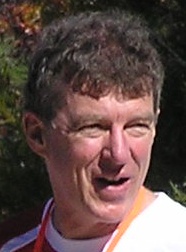
Ian Hector Frazer is a Scottish-born Australian immunologist, the founding CEO and Director of Research of the Translational Research Institute (Australia). Frazer and Jian Zhou developed and patented the basic technology behind the HPV vaccine against cervical cancer at the University of Queensland. Researchers at the National Cancer Institute, Georgetown University, and University of Rochester also contributed to the further development of the cervical cancer vaccine in parallel.
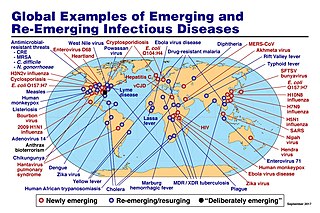
An emerging infectious disease (EID) is an infectious disease whose incidence has increased recently, and could increase in the near future. The minority that are capable of developing efficient transmission between humans can become major public and global concerns as potential causes of epidemics or pandemics. Their many impacts can be economic and societal, as well as clinical. EIDs have been increasing steadily since at least 1940.
This is a list of books and monographs by Sir Frank Macfarlane Burnet, arranged thematically, with original titles, publishers and dates of publication. Burnet wrote widely on virology, immunology and later in life on popular science issues. He wrote over 500 papers and 31 books, several of which were published in multiple editions; 15 of those books followed his retirement as director of the Walter and Eliza Hall Institute.

Medical microbiology, the large subset of microbiology that is applied to medicine, is a branch of medical science concerned with the prevention, diagnosis and treatment of infectious diseases. In addition, this field of science studies various clinical applications of microbes for the improvement of health. There are four kinds of microorganisms that cause infectious disease: bacteria, fungi, parasites and viruses, and one type of infectious protein called prion.

Fairfield Infectious Diseases Hospital, originally known as Queens Memorial Infectious Diseases Hospital, operated from 1904 to its closure in 1996. Perched high on the banks of the Yarra River at Yarra Bend in the inner Melbourne suburb of Fairfield, it developed an international reputation for the research and treatment of infectious diseases. When it closed, it was the last specific infectious diseases hospital in Australia.

Walter Ian Lipkin is the John Snow Professor of Epidemiology at the Mailman School of Public Health at Columbia University and a professor of Neurology and Pathology at the College of Physicians and Surgeons at Columbia University. He is also director of the Center for Infection and Immunity, an academic laboratory for microbe hunting in acute and chronic diseases. Lipkin is internationally recognized for his work with West Nile virus, SARS and COVID-19.
Ian David Gust AO, FRCPA, FRACP, MASM, FT is an Australian medical researcher, virologist, and former science administrator. Gust's area of work is in the development of drugs and vaccines against viral diseases and he is best known for the development of vaccines against the Hepatitis A virus. He currently serves as a non–executive company director and consultant.
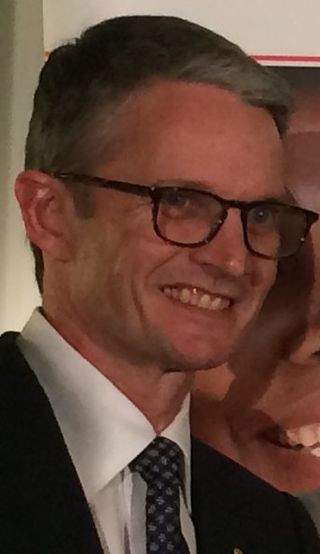
Brendan Scott CrabbFASM is an Australian microbiologist, research scientist and director and chief executive officer of the Burnet Institute, based in Melbourne, Victoria, Australia.

The Kirby Institute is a medical research organisation affiliated with the University of New South Wales and based on UNSW's Kensington campus. Founded in 1986, its initial research focus on HIV/AIDS has expanded over time to include viral hepatitis, sexually transmitted infections and a range of other infectious diseases.

ZMapp is an experimental biopharmaceutical drug comprising three chimeric monoclonal antibodies under development as a treatment for Ebola virus disease. Two of the three components were originally developed at the Public Health Agency of Canada's National Microbiology Laboratory (NML), and the third at the U.S. Army Medical Research Institute of Infectious Diseases; the cocktail was optimized by Gary Kobinger, a research scientist at the NML and underwent further development under license by Mapp Biopharmaceutical. ZMapp was first used on humans during the Western African Ebola virus epidemic, having only been previously tested on animals and not yet subjected to a randomized controlled trial. The National Institutes of Health (NIH) ran a clinical trial starting in January 2015 with subjects from Sierra Leone, Guinea, and Liberia aiming to enroll 200 people, but the epidemic waned and the trial closed early, leaving it too statistically underpowered to give a meaningful result about whether ZMapp worked.
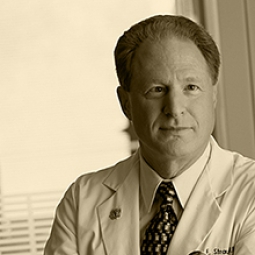
Stephen E. Straus was an American physician, immunologist, virologist and science administrator. He is particularly known for his research into human herpesviruses and chronic fatigue syndrome, and for his discovery of the autoimmune lymphoproliferative syndrome genetic disorder. He headed the Laboratory of Clinical Investigation of the National Institute of Allergy and Infectious Diseases, National Institutes of Health (NIH), and served as the founding director of the NIH's National Center for Complementary and Alternative Medicine.
Lisa Maher is Professor and head of Viral Hepatitis Epidemiology, at the Kirby Institute for Infection and Immunity, at the University of New South Wales and was made Member of the Order of Australia in 2015. She was awarded an Elizabeth Blackburn Fellowship, in Public Health from the NHMRC, in 2014. She is a fellow of the Australian Academy of Health and Medical Sciences.